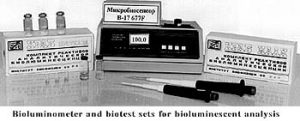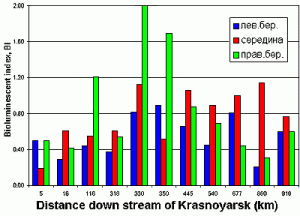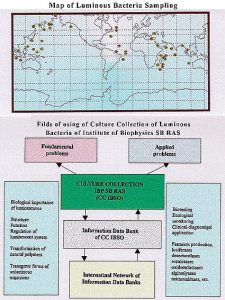Institute of Biophysics, SB RAS, Krasnoyarsk
Head of the Institute:
Andrey G.Degermendzhy, Doctor of Sciences (Physics and Mathematics)
Akademgorodok, Krasnoyarsk, 660036, Russia
Tel.: (3912)431579; Fax: (3912)433400
Principal researchers:
E.K.Rodicheva, Ph.D. (Biology)
Tel: (3912)494527; Fax: (3912)433400
email: ccibso@cc.krascience.rssi.ru
Participating Researchers:
G.A.Vydryakova, researcher
A.M.Kuznetsov, Ph.D., senior researcher
S.E.Medvedeva, Ph.D. (Biology), senior researcher
Project objectives
To provide for the solution of the fundamental problem of biology associated with preservation and rational use of microbial diversity. The project implies: 1) to maintain, inventory and study the collection fund, to analyse and systematise results of experiments to compile databases; 2) to develop and implement in actual nature management practice a lyophilised luminous bacteria-based bioluminescent assay to detect integral toxicity of waters, to test heavy metals, phenol compounds, pesticides, etc.; 3) to search for strains producing target products: luciferases, oxidoreductases, chitinases, neuraminidases, decarboxilases, restrictases.
Background and significance of objectives
Collections of cultures as gene fund storage are the national treasure of every country. An excessive anthropogenic load on natural objects resulting in an alteration and not infrequently complete extinction of biological species makes preservation of diversity of biological objects inhabiting our planet a topical issue. The necessity of extraordinary measures to preserve biological diversity was expressed by the governments of 179 countries in the Convention on Biological Diversity adopted by the UN World Environmental Conference. Confronted by problems of inventorying, preserving and long-term use of biological diversity, including microbiological diversity the international community of scientists establishes in many countries collaborating networks of servicing and research collections. The World Federation of Culture Collections (WFCC) coordinates activities of several interacting international systems: The World Center for Data on Microorganisms (WCDM) and the International Data Network for Microorganism Strains and Cell Lines. The Microbial Strain Information Network of Europe (MINE) and the World Network for Microbial Resources Regional Centers (MIRCEN) are deeply involved in this work.
Over the years (since the 60s) the Institute has been maintaining a unique collection of luminous bacteria containing about 700 strains isolated in different points of the World Ocean and typical strains of luminous bacteria received from other collections. Having a unique visual marker luminous bacteria are an object convenient in solving fundamental problems and important applied problems of medicine, technical microbiology, environment protection. In addition, they are a source of various promising target products (luciferases, oxidoreductases, dehydrogenases, restrictases of different specificity, chitinase, etc.). Luminous bacteria form a basis for development of a highly sensitive integral bioassay for integral toxicity to monitor the environment.
The Collection of the Institute of Biophysics is developing an information databank on basic properties of luminous bacterial cultures, peculiarities of their metabolism, cultivation and storage conditions, and applied use. Basic data about the cultures in storage have been put into WFCC information cards. Primary information about microbiological resources stored in the Collection of the Institute of Biophysics has been published in the “Guide to Microorganism Cultures” (Biotechnology, Sofia, Bulgaria, 1990, No 2-4), in the information bulletin of the World Microbiological Society (MSDN News Letter, 1992, No 6). The Catalogue of Cultures of luminous bacteria of the Institute of Biophysics is available on magnetic carriers in MS-DOS format for personal computers. The catalogue of the cultures of luminous bacteria of the Institute of Biophysics was published in 1997 by the “Nauka” Publishing House. Databases on 100 cultures from the Collection are registered as “IBSO Siberian Luminous Bacteria” at the MSDN international network server, which has the electronic version of the English version of “The IBSO Catalogue of Cultures of Luminous Bacteria” ( http://www.bdt.org.br/bdt/msdn/ibso ).
High sensitivity of the luminescent system of luminous bacteria to microquantities of various substances facilitates their employment as integral toxicity bioassay. Simple to measure luminescence, rapidity of the method, feasibility of automating measurements and statistical processing of data makes the luminous bacteria advantageous over other biological assays. Under development at the Collection of the Institute of Biophysics is a basic integral bioassay based on lyophilised luminous bacteria and a luminescent system isolated from them to monitor the environment. In expeditions of 1993-1998 experimental specimens of the bioassay under development were used to examine contamination of water bodies of the Altai regions, the Yenisei, Kan, Angara rivers and their tributaries at water intakes, sites of industrial discharge, waste waters of the pulp-and-mill works. The lyophilised luminous bacteria-based bioassay was successfully used to detect toxicity of wastewater’s and water purification facilities in Riga and Alma-Ata cities and was highly assessed by experts and recommended for ecological monitoring. The preparation under development is compatible in its parameters with “Microtox”, “LUMIStox” preparations used abroad to evaluate water quality in rivers and lakes; it is reliable and more accessible for domestic market.
Research plan: approaches and methods
Objects under study: strains of various species of luminous bacteria of the Culture Collection of the Institute of Biophysics. Methods: microbiological, physiological-biochemical, electron-microscopic, species identification methods, cultivation and maintenance methods, biochemical methods to produce enzymes, biotechnological methods to produce bacterial luminescence reaction kits; bioluminescent methods of analysing biologically active substances.
Expected results
Implementation of the project shall facilitate preservation, investigation and rational use of the unique collection of marine microorganisms. Investigation, analysis and systematisation of data on the properties of luminous bacteria shall form the basis to compile up-to-date databases on experiments of major physiological-biochemical and morphological-cytological properties of the cultures of the Institute and bibliographical database on taxonomy and physiology of luminous bacteria and collection work. Selection of strains producing luciferases, restrictases and other enzymes shall make it possible to meet demands of biotechnologists. Selection of toxic-sensitive strains shall improve the bioluminescent biotest to determine water quality. Development and implementation into actual nature management practice of a lyophilised luminous bacteria-based bioluminescent bioassay shall facilitate evaluation of natural water quality and effluents of industrial enterprises. The bioassay can be used to monitor the quality of doping in drilling deep holes.
List of publications of participants related to the project
-
Kratasyuk V.A., Kuznetsov A.M., Rodicheva E.K. et al. Problems and Prospects of Bioluminescence Assays in Ecological Monitoring // Siberian J. Ecol. – 1996. – ¹ 5. – P. 397-403. (In Ruass.).
-
Kuznetsov A.M., Rodicheva E.K., Shilova E. Biotest based on lyophilized luminous // Biotechnology. – 1996. – ¹ 9. – P. 57-61.
-
Repin V.E., Puchkova L.I., Rodicheva E.K., and VYDRYAKOVA G.A. Endonucleases of restriction of symbiotic luminous bacteria // Applied Bioch. Microbiol. – 1997. – Vol. 33, ¹ 2. – P. 152-155.
-
Rodicheva E.K., Vydryakova G.A., Medvedeva S.E. Catalogue of Luminous Bacteria Cultures, 1997. – Novosibirsk: Nauka. – 125 p.
-
Kuznetsov et al. Investigation of reagents properties for bioluminescent biotests // Siberian J. Ecol. – 1997. – ¹ 5. – P. 459-465. (In Ruass.).
-
Rodicheva E.K., Medvedeva S.E., Vydryakova G.A., Chugaeva Yu.V., Kuznetsov A.M. Gene Pool Maintenance and the Prospects for Using a Special-Purpose Luminous Bacteria Collection // Applied Bioch. Microbiol. – 1998. – Vol. 34, ¹ 1. – P. 75-82.
-
Kuznetsov A.M., Rodicheva E.K., Medvedeva S.E. Biotesting of sewage and river water by liofilyzed luminous bacteria biotest / Field Screening Europe Proceed. of the First International Conference on Strategies and Techniques for Investigation and Monitoring of Contaminated Sites / Eds. Johannes Gottlieb, Heinz Hotzl, Karin Huck, Reinhard Niessner. – Dordrecht o.a.: Kluwer Academic Publishers. – 1997. – P. 211-215.
-
Kuznetsov A.M., Rodicheva E.K., Medvedeva S.E. Biotesting of sewage and river water by lyophilized luminous bacteria biotest // Field Analytical Chemical Technologies. – 1998. – Vol. 2, ¹ 5. – Š. 267-275.
Different water quality zones in the Yenisei River



